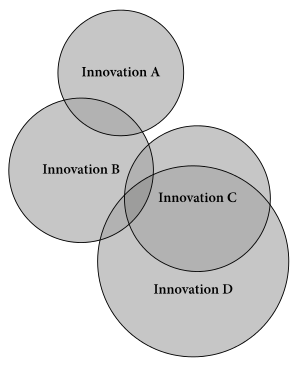Wave theory (linguistics)

The wave theory of language development was originally introduced into historical linguistics and dialectology by Hugo Schuchardt in one of his Leipzig lectures in 1870. Johannes Schmidt ( 1843 - 1901 ) developed the concept further in linguistics . In his analysis of the relationships between the Indo-European languages in 1872 , he founded the concept of the gradual spatial spread of linguistic innovations, or wave theory for short.
The wave theory was directed against the then emerging doctrine of the absence of exception of the sound laws , with which the young grammarians had a decisive influence in Indo-European linguistics until the 1930s . In analogy to wave theory in physics, Johannes Schmidt saw developments in the Indo-European languages and other language families as the result of overlapping. This interference and minor changes would arise and propagate in small groups. The effect would become weaker and weaker as it spreads, similar to the waves produced by a stone thrown into the water.
The wave theory supplements the family tree theory developed by August Schleicher ( 1821 - 1868 ) , according to which languages develop from original languages analogous to the evolution of biological species . With the help of wave theory, the spread of certain linguistic phenomena across language boundaries can be explained more easily than with evolutionary models, such as genetic drift .
Web links
- Christian Lehmann, Language Change, chap. 7.4: Genetic language relationship, family tree vs. Wave theory
- Jacques François: The separation of the Romance-speaking area. Université de Caen & LATTICE (UMR 8094, Paris 3 - ENS), lecture at the Institute for Romance Studies at the University of Stuttgart, 10. June 2015
Individual evidence
- ↑ From Johannes Schmidt: The relationships of the Indo-European languages. H. Böhlau, Weimar 1872
- ^ Daniela Pirazzini: Theories and methods of Romance linguistics. Walter de Gruyter, Berlin 2013, ISBN 3-11-030989-0 , p. 30
- ^ Bernhard Hurch: From the periphery to the center: Hugo Schuchardt and the innovations in linguistics. In: Karl Acham (Ed.): Art and Science from Graz. Vol. 2.1., Art and Humanities from Graz. Böhlau, Vienna 2009, ISBN 3-205-77706-9 , pp. 1–20 ( Online ( Memento of the original from November 17, 2015 in the Internet Archive ) Info: The archive link has been inserted automatically and has not yet been checked. Please check the original and archive link according to instructions and then remove this note. , PDF)